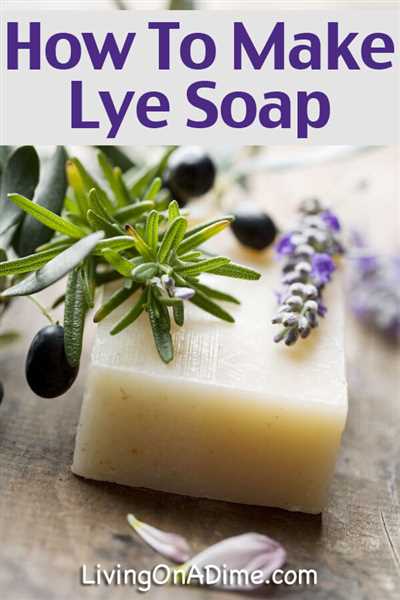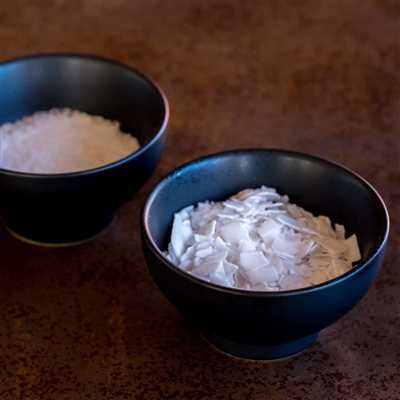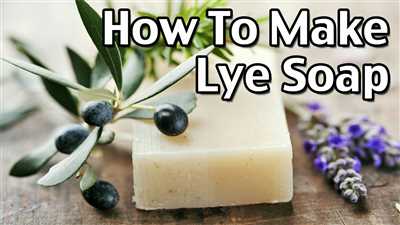
Soapmaking is an age-old craft that has been passed down through generations. In today’s digital age, where many commercial soaps are filled with chemicals and artificial additives, more and more people are turning to homemade soap as a great alternative. Making your own soap allows you to control the ingredients, ensuring a natural and nourishing product for your skin.
One of the key components in soapmaking is lye, also known as sodium hydroxide. Lye is a powerful caustic soda that, when mixed with water, produces a solution that can dissolve fats and oils. It’s important to handle lye with care, as it is a high-temperature and corrosive substance. Always wear protective gear and work in a well-ventilated area or outdoors when dealing with lye.
To collect lye, many soapmakers used to make their own by burning wood and collecting the ashes. This process produced potassium hydroxide, also known as potash, which could be used to make soft soaps. Nowadays, lye is readily available in stores and can be purchased in its pure and distilled form.
When making lye soap, it’s important to note that lye should never be added to the oils without being fully dissolved in water first. This can cause a violent reaction and is extremely dangerous. The lye solution should be slowly poured into the oils while continually stirring until fully incorporated.
Another important step in soapmaking is the trace, which is the point at which the soap mixture thickens and becomes opaque. This can take some time and requires patience. Once the trace is achieved, the soap can be poured into a mold or container and left to cure for several weeks before it’s ready to be used. During this time, the soap undergoes a saponification process, in which the fats and lye react to produce a solid soap.
There are many uses for homemade lye soap, from washing your hands and body to cleaning household items. Some people even claim that lye soap can repel insects, such as chiggers. While there may not be scientific evidence to support this claim, it’s worth a try for those living in areas prone to chigger bites.
In conclusion, making lye soap is a rewarding and fulfilling process that allows you to create a natural and personalized soap for yourself and your loved ones. With the right ingredients, precautions, and techniques, anyone can become a soapmaker. So why not give it a try and experience the joy of soapmaking firsthand? Get ready to collect your lye, gather your oils, and embark on this fascinating journey into the world of soapmaking!
- Making Lye Soap
- How to make lye solution for soap making
- What is lye solution?
- How to make lye solution
- Collect the Ash
- What is lye and why is it used in soap
- How is lye made?
- What are the uses of lye in soapmaking?
- What is lye and why it’s in our soaps
- Video:
- How To Make Old Fashioned Soap / How to make Lye Soap
Making Lye Soap

Making lye soap is a process that involves the chemical reactions between lye, which is also known as sodium hydroxide, and fats or oils. Lye soap has been used for centuries as a natural and effective cleanser for the skin.
To make lye soap, you will need lye, fats or oils, and a container to mix them in. It’s important to note that lye is a caustic substance and can be dangerous if not handled properly. When working with lye, it is crucial to wear protective gear such as gloves and goggles, and to work in a well-ventilated area.
Before you begin making lye soap, make sure you have collected all the necessary ingredients and tools. You will need distilled water, lye (sodium hydroxide), fats or oils of your choice, a heat source, a heat-resistant container, and a digital scale to measure the ingredients accurately.
To start, measure the correct amount of lye and distilled water using your digital scale. Slowly pour the lye into the water while stirring continuously. Be careful as this step can be dangerous, and the reaction between lye and water can be violent. Stir until the lye is fully dissolved in the water, creating a lye solution.
In a separate container, melt the fats or oils over low heat. Once the fats or oils have melted, slowly pour the lye solution into the container while stirring constantly. This process is known as saponification, where the fats or oils react with the lye solution to produce soap.
Continue stirring the mixture until it reaches a trace, which means it has thickened slightly and leaves a trace when stirred. At this point, you can add any desired additives, such as essential oils or herbs, to enhance the fragrance and benefits of the soap.
Pour the soap mixture into molds and let it cool and harden for several hours or overnight. Once the soap has fully solidified, it can be removed from the molds and cut into bars. Allow the soap bars to cure for at least four weeks before using them.
It’s important to note that lye soap should never be used before it has fully cured. During the curing process, lye soap becomes milder and gentler on the skin. Using lye soap before it has fully cured can cause skin irritation or burns.
Many soapmaking enthusiasts enjoy making their own lye soap because it allows them to control the ingredients and create a product that is tailored to their specific needs. Additionally, making lye soap is a great way to connect with natural ingredients and learn about the chemistry involved in soapmaking.
As with any chemical process, make sure to research and follow proper safety precautions when making lye soap. Always work in a well-ventilated area and wear protective gear to ensure your safety. Soapmaking can be a rewarding and enjoyable hobby, but it’s important to take the necessary precautions to avoid any accidents or injuries.
So, if you’re looking to make your own lye soap, be sure to gather all the necessary supplies, do your research, and enjoy the process of creating something natural and beneficial for your skin!
How to make lye solution for soap making
When it comes to soap making, one of the most important steps is creating a lye solution. Lye, also known as sodium hydroxide, is a key ingredient in soap making and is used to produce a natural, high-quality soap. This article will explain how to make lye solution for soap making.
What is lye solution?
Lye solution is a liquid that contains lye (sodium hydroxide) dissolved in water. It is often used by soap makers to initiate a chemical reaction with fats and oils, resulting in the formation of soap. Lye solution is necessary to convert these fats and oils into soap, making it an essential component in the soap making process.
How to make lye solution
To make lye solution, you will need lye (sodium hydroxide) and distilled water. It is important to note that lye is a caustic substance and requires careful handling. Make sure to wear gloves, protective eyewear, and work in a well-ventilated area when making lye solution.
- Collect all the necessary equipment and ingredients before starting. You will need a heat-resistant container (such as a glass or stainless steel container), distilled water, and lye.
- Measure out the correct amount of distilled water according to your soap recipe. Make sure to use distilled water rather than tap water as it is free from impurities that could affect the soap making process.
- Slowly pour the measured water into your heat-resistant container.
- Add the lye to the water, slowly and carefully. Never pour water into the lye, always pour the lye into the water. This is to prevent a violent reaction from occurring.
- Stir the mixture well until the lye is fully dissolved. This may take some time, so be patient and thorough in your stirring.
- Once the lye is fully dissolved in the water, the solution is ready to be used in soap making. It’s important to note that lye solution should always be added slowly to fats and oils, never the other way around. This is to ensure a proper chemical reaction and avoid any potential dangers.
Now that you know how to make lye solution for soap making, you can confidently start creating your own homemade soaps. Just remember to wear protective gear, work in a well-ventilated area, and follow proper safety precautions. Soap making is a great way to get creative and produce high-quality, natural soaps without the need for harsh chemicals. Enjoy your soap making journey!
Collect the Ash
Before you can begin making lye soap, you will need to collect ash from wood. This ash is a key ingredient in the soapmaking process. Make sure you gather the ash from a clean wood source, such as hardwood or fruitwood, as other types of wood may contain chemicals or impurities that can harm your skin.
Here’s how to collect the ash:
- Find a well-ventilated outdoor area to perform this step, as it involves burning wood.
- Build a fire using the wood you have chosen. Make sure the fire is contained in a safe and controlled manner.
- Let the wood burn until it becomes ash. This process may take several hours or even a day, depending on the amount of wood.
- Once the fire has burned out and the wood has turned into ash, carefully collect the ash and place it into a heat-resistant container. An aluminum container would be a good choice.
- Wear protective gloves and ensure that you do not inhale the ash, as it can be harmful to your respiratory system.
It’s important to note that the ash you collect is known as lye or potash. Lye is a strong alkaline substance that is used in soapmaking to create a chemical reaction with fats and oils. Without lye, the soap would not be able to form and solidify properly.
Why use wood ash? Wood ash contains potassium carbonate, also known as potash, which is an ingredient used to make lye. It’s a natural source of this essential chemical and has been used for centuries in soapmaking.
Collecting ash is just one step in the soapmaking process, but it is a crucial one. Once you have collected the ash, it can be dissolved in distilled water to make a lye solution. This solution will be used in combination with fats or oils to create soap.
Remember to always follow proper safety precautions and wear protective gear when working with lye or any other chemicals. Soapmaking can be a great hobby or business, but it’s important to do it safely and with knowledge of the process.
What is lye and why is it used in soap
Lye is a strong alkali, also known as sodium hydroxide (NaOH). It is a key ingredient in soapmaking and is used to create a chemical reaction called saponification, which is the process of turning fats or oils into soap.
In soapmaking, lye is added to water to create a lye solution. This solution is then combined with fats or oils, which are known as soapmaking oils. The chemical reaction between lye and the oils produces soap.
But why use lye in soap? Lye is used because it is necessary for the soapmaking process. Without lye, there wouldn’t be a chemical reaction, and the oils would simply remain oils, unable to become soap. Lye is the key ingredient that transforms the oils into soap.
It’s important to note that lye is a caustic substance, which means it can cause burns and skin irritation. When working with lye, it’s crucial to wear protective gear, such as gloves and goggles, and to work in a well-ventilated area, preferably outdoors.
Many commercially produced soaps do not list lye as an ingredient, but that doesn’t mean lye is not used in the soapmaking process. The lye is completely used up during saponification, so there is no lye left in the final product. However, lye is an essential ingredient in soapmaking.
How is lye made?

Lye can be made from wood ashes or it can be purchased commercially. The traditional method involves collecting wood ashes in a container and pouring water through them. The water collects the lye from the ashes, creating a liquid solution.
Commercially available lye, also known as caustic soda, is often made through a high heat process that involves boiling a solution of sodium carbonate (commonly known as soda ash) with water. The resulting solution is then evaporated until the lye crystals are obtained. This lye can then be dissolved in water for soapmaking.
What are the uses of lye in soapmaking?
Lye is primarily used in soapmaking to create a chemical reaction that turns oils into soap. The resulting soap can be used for cleaning, personal hygiene, and various other purposes. Lye soap has been used for centuries and is still a popular choice due to its ability to effectively cleanse the skin.
One great benefit of using lye in soapmaking is that it allows makers to create natural soaps by using simple ingredients like oils and lye. These natural soaps are often free of added chemicals and artificial fragrances, making them suitable for those with sensitive skin or allergies.
When making soap at home, it’s important to handle lye with caution and to always follow safety guidelines. The lye should be slowly and carefully stirred into the water, never the other way around. The mixing container should be made of a material that can handle the caustic nature of lye, such as stainless steel or heat-resistant plastic. It’s also crucial to ensure that the lye solution is fully dissolved and cooled before it is added to the oils.
In conclusion, lye is a key ingredient in soapmaking that is used to create a chemical reaction and turn oils into soap. It is a powerful substance that requires careful handling, but when used correctly, it produces high-quality soap with many benefits for the skin.
What is lye and why it’s in our soaps
Lye, also known as sodium hydroxide, is a key ingredient in soapmaking. It is a chemical compound that is used in soapmaking to create a chemical reaction that turns natural oils and fats into soap.
When lye is mixed with a liquid, it produces a chemical reaction called saponification, which means the combination of fat and alkali to make soap. This reaction involves the lye breaking down the fats and oils into fatty acids and glycerin, resulting in the formation of soap.
So, why is lye used in our soaps? Lye is essential for soapmaking because it is the catalyst that enables the transformation of oils into soap. Without lye, soap cannot be made.
Before using lye in soapmaking, it is important to note that lye is a caustic substance that can cause burns and irritate the skin. Therefore, it is crucial to handle lye with caution and wear protective gear, such as gloves and goggles, to prevent any accidents.
Soapmakers often use a solution of lye and distilled water in their soap recipes. Lye can be purchased as a solid form, usually in the shape of flakes or beads, and needs to be dissolved in liquid before it can be used.
During the soapmaking process, lye is slowly poured into a mixture of oils and stirred well to ensure that it fully dissolves. This mixture is then poured into a container, often made of aluminum or a digital scale, and left to cure for several weeks.
It’s important to note that once the chemical reaction occurs and saponification takes place, the lye is no longer present in the soap. The soap is safe to use and does not contain any harmful chemicals.
So, when you use a bar of natural lye soap, you can be confident that it is made with care and does not contain any unnecessary additives. It’s a great choice for those looking for a natural and gentle soap for their skin.









